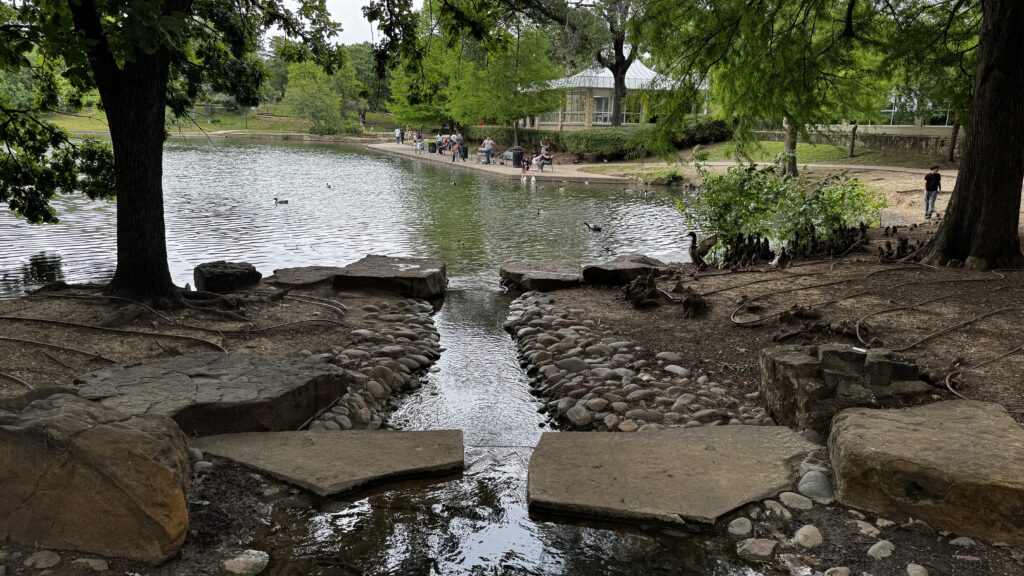Pool Is Power
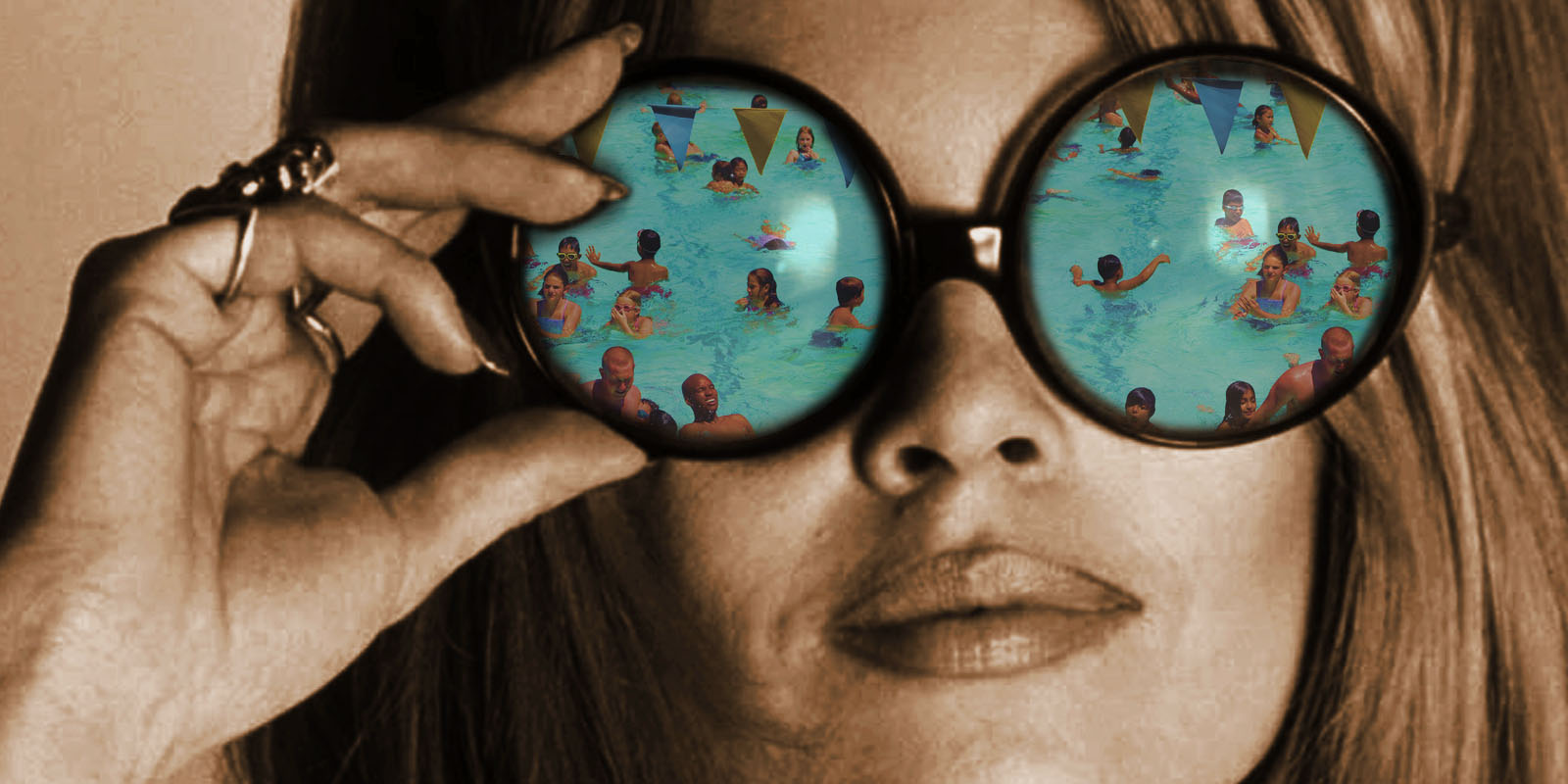 Art Credit / Ryan Jensen
Art Credit / Ryan Jensen
As a kid, I remember wondering, “Who do I know that has a pool?”
This was a time in the early ‘80s when we were more comfortably left alone for the summers while our parents were at work + my brother and I looked after our little sis. We had bikes, and we knew we could get to the lake to cool off, but in reverse, we arrived home more tired and exhausted from the journey back. In Texas, the dry heat in August hits hard—everything turns brown and dead (kind of). Sunburns, bug bites, long hot boring days were just part of the vaporizing, soul crushing “character-building.” I hated it. If I only had a pool, I could eliminate “the return” from our favorite swimming hole. I fantasized about walking out the back door, finding my dreams on a diving board with a 12-foot-deep oasis. The reality was Super Mario and hot pockets.
Heat is uncomfortable, annoying, and dangerous. Pools, though, are nice! They are refreshing and jovial with a side of emotional recharge. They are about friends and good times and sometimes, alcohol. Humans seek this expression of joy as a counterpoint to harsh environments, such as hot and dry plains with very little water. It’s no wonder that most thriving cities are coastal. They understand this relationship between humans and water—the basis of happiness and survival.
If you aren’t coastal (such as DFW), you can still be drawn to the water’s edge. Dallas’ humble beginnings were on a natural spring, allowing travelers to pause and recharge as manifest destiny took place. Imagine a time before the railroad when all you could see was endless grasslands—on horseback driving cattle from place to place for trade and survival. Yet, under the large groves of mighty oaks and pockets of the undisturbed Trinity River, one could find cool breezes that broke the torture of boundless dehydrated misery. Over the years, we (DFW) got busy creating a place of commerce and culture, where all types of people could thrive. Drawing thousands to the metroplex each year, we are not teasing ourselves into thinking that water is everywhere. We live here for the opportunities of commerce in modern times, not so much natural beauty. Collectively, we are well positioned to provide a fruitful economic environment—but when it’s hot, like really hot, we sure do slow our roll, finding ourselves indoors at the mall or movie theatre—with air conditioning. So, how do we beat the heat and what are the potential pitfalls for each concept?
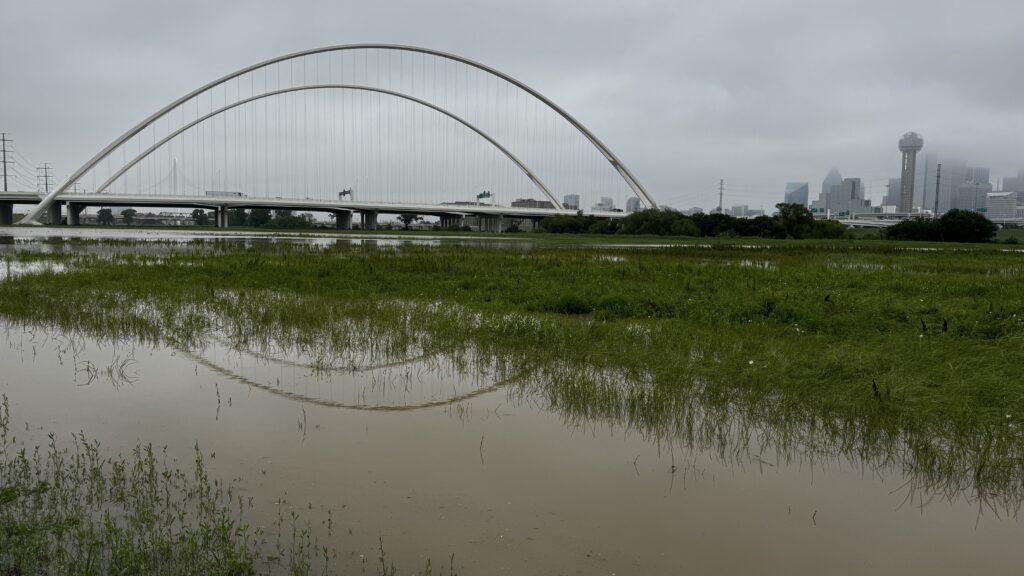
Private Pools
Pools are costly. In general, they take approximately 3-12 weeks to build and can be made of concrete, fiberglass, vinyl-lined, or aluminum. If concrete, you can expect a longer life span (50+ years), a complicated plumbing and pump system, expensive chemicals and maintenance plans, and maybe an added service expense (i.e., the pool guy). You will often find secondary fences around the pool for otherwise already fenced-in backyards, intended to keep kids from drowning but adding to the visual clutter nonetheless. Prices go up as you consider unstable soils, patio settings, and additions like trellises, decking, landscape features, hot tubs, lighting, and sunbathing areas. Typical sizes are 20’ x 40’ x 5’ with baselines (not including the aforementioned add-ons) in the $60,000 range. A basic concrete water pit with pumps and chemicals without designed serenity has a buy-in of approximately $75 / SF.
This is a cost that affluent homeowners are willing to afford. I could imagine that having a private space to be fully comfortable out of public view would be super enticing. I’m certain that not everyone is okay with stripping down to the skimpiest of swimwear in public. Let’s be real—there are birthmarks, back hair, and bad tattoos. We’ve got cellulite, super-gross toenails, and stubble. We are beautiful and bold, but also sometimes better left to our own private backyard vacations. On the flip side, many young adults want this type of clothes-off attention. Regardless of how comfortable you are with your body in public, it’s obvious that the backyard oasis will be a constant real estate trend for hotter cities.
My intuition was that poorer neighborhood’s pool count would be drastically lower than richer suburban conditions. Simply check the “has pool” box on the Zillow filter list to see for yourself. As indicated, where the higher property values are, the more prevalent the pool count. This is obvious and also an indicator of socio-demographic concepts. In the DFW Metroplex during May 2025, 3,487 homes listed pools, touting an average selling price of $513,569 at $272.97 / SF and sitting on the market for an average of 58 days. Redlining and white flight have resulted in large swaths of demographic shift from urban cores to suburban and ex-urban communities. The creation of generational wealth, privilege, and posterity for one group is proportional to eroding those concepts for another. In other more familiar words, “the rich get richer and poor get poorer” is all too evident in houses with private backyard pools.
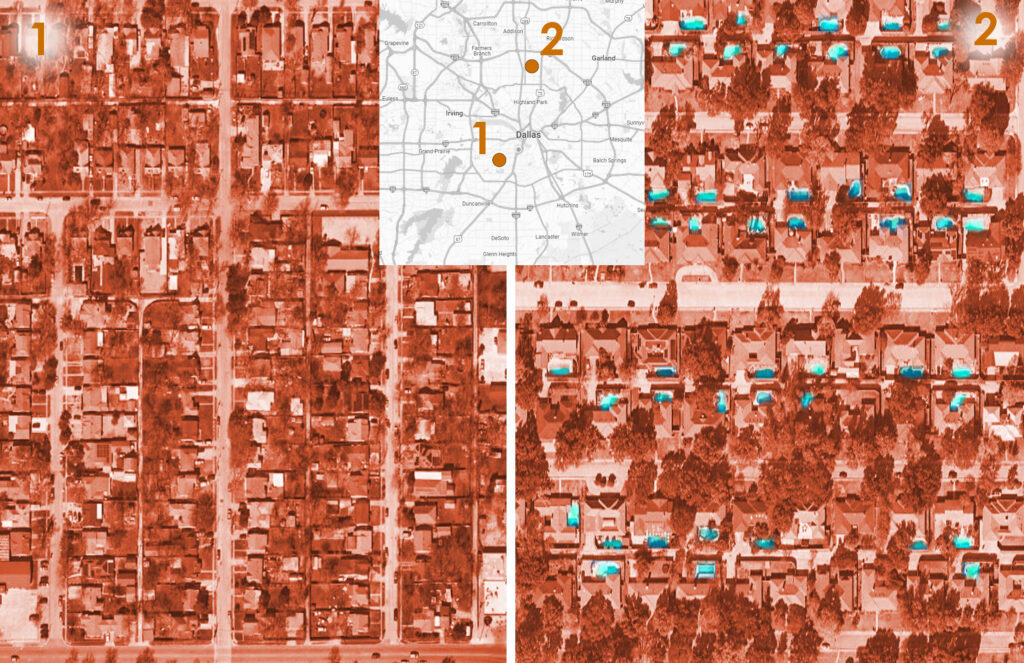
Post pandemic pool construction has been on a steady 40% growth trend. The U.S. has 10.7 million pools nationwide (10.4 in the residential sector), representing about 8% of U.S. households that have a pool. Additionally, 309,000 public or commercial pools bring the total per capita to 1 pool for every 31 persons. Florida leads the race, but California and Texas follow closely behind. Additionally, 59% of pools are in-ground while 41% are above. There is also a disparity geographically: Minnesota has pool density around 1 per 109 people, while Arizona has 1 per 13 people. It goes without saying that where the climate is hot and the population has money, that’s where you will find the pools.
Stock Tank Pools
I’m sure you’ve seen plenty of variations on Pinterest. Some painted, and some with a deck, but nearly all accompanied with potted plants or string lights nearby. With a diameter of 8 to 10 feet, they are usually a galvanized metal tank about 2 feet deep with a couple of 2-inch holes drilled in the side to support the sand filter’s intake and output fittings. Put one in the shade with a pump and you could float freely in dependable 85-degree water even in blistering 100+ temps. This I know from personal experience, and at a fraction of the cost (+/- $2,500 including delivery). This solution strikes a nice balance between temporary vs. permanent, giving the backyard experience for those days when venturing out is just not in the cards.
Community Pools
What about people with less money—they deserve to cool off too! Why not utilize a more extensive network of community pools? The New Deal in the ‘30s brought about the biggest burst in public pools to serve the community, totaling 750 new pools + hundreds more renovations nationwide. Beginning in the late ’40s, and heightening in the ’60s, segregation and civil uneasiness caused a whiplash responsible for closing many public pools. In fact, the lack of pools in predominantly black communities was considered a major reason for urban unrest, especially in southern climates! Taxes and politics have changed the game for many areas that once provided this care-free gathering in times of extreme heat.
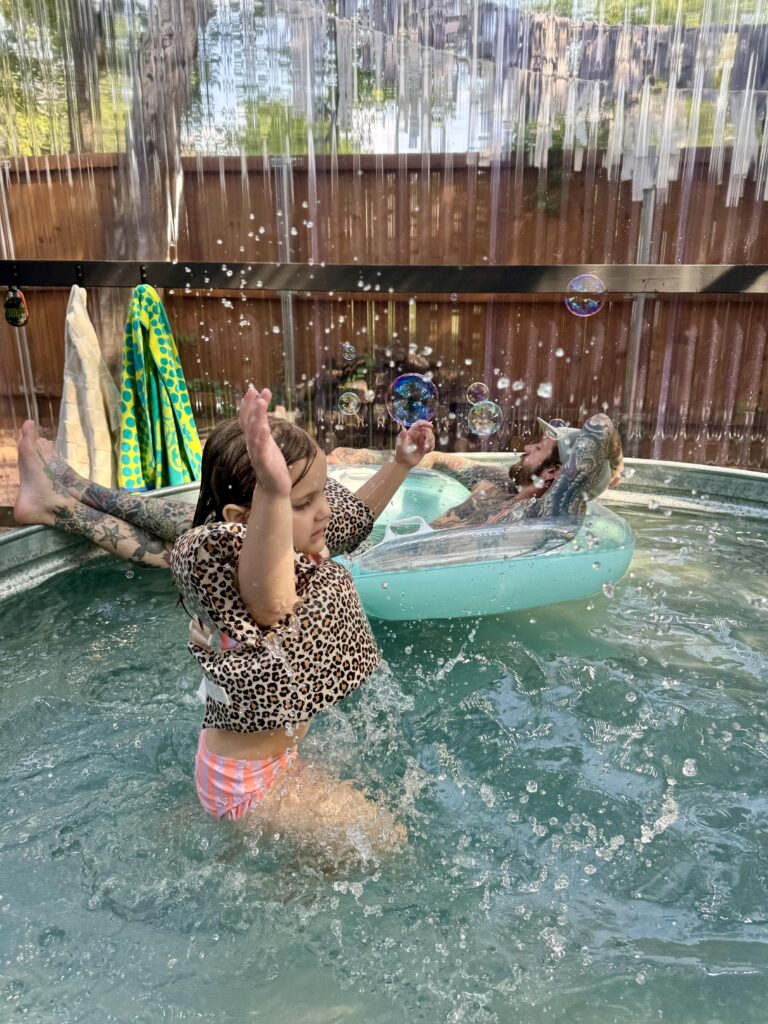
In the picture below you will notice a well-done public pool in Oak Cliff. It has some recall (but with more bells and whistles) to my childhood favorite, Dove Pool in Grapevine, TX. I clearly remember having a blast and creating lasting memories with my siblings. When we were promised a day at the community pool, we were filled with excitement. Not only was it pure joy, respite from the heat, and LOTS of needed exercise, but as I learned later in life, a primer for social behavior and the fruits of gathering in public. This seems like a no-brainer but remember—cell phones had not been implemented and definitely not social media. These modern entities/distractions hold the next generation captive from experiencing the regular social outings like my peers and I got naturally.
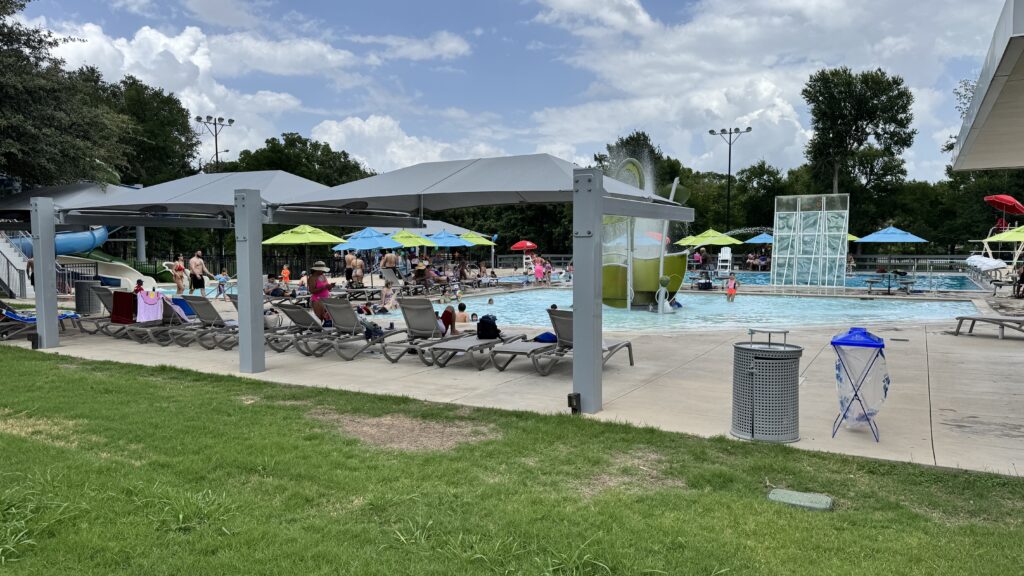
Newer subdivisions create amenity packages that provide a pool scene with sometimes multiple pools that mimic the community pool concept. Apartments have been doing this for a while and, though not always the best environments, can still scratch that itch. Often, the pools are squeezed in between uncomfortably public facing areas or placed on top of parking decks with shallow depths, creating warm, undesirable water. They do still have a draw for residents seeking outdoor gatherings, albeit in cramped urban-esque dwellings. This setup is a softball to counter the isolated private backyard, “I get mine” mentality. Strangely, between the apartment wrap products and the sprawling gated compounds, there does seem to be a driving force to help folks gather [out in the wild] looking for something more than smart screens and gaming consoles.
All pools evaporate. The hotter the pool and the hotter the air, the quicker that process takes place. In warm climates, evaporation is roughly 2 inches or more per week. The average size of a residential pool is approximately 800 square feet translating to 136 gallons lost per day (feel free to check my math). So only $3 per week of expense (at $0.03 per 10 gallons)—but what about water scarcity? What about rising temperatures with climate change?
In addition to evaporation, pools can lose thousands of gallons from cracks in the side wall or leaky pipes. Remember, the basic construction is steel rebar tied to the edge of a hole, sprayed with gunite (a concrete add mix), and then coated with finishing plaster. As the earth settles, cracks become inevitable. In commercial construction, the soils are prepped and backfilled for stability, but very rarely does that level of care get executed in private sectors.
When comparing private pool ownership to the Dallas water conservation plan of 2024, you will notice that gallons per capita per day (GPCD) are set at around 51 gallons, which is nearly one-third of the anticipated water loss for just evaporation in one pool. To me, this translates as one pool-owning resident is three times as harmful for water scarcity than a non-pool-owning one. In places like Arizona with 1 pool for 13 residents, coupled with their growth rate and already diminishing water reserves, one could see how this is a looming catastrophe.
Splash Pads
Splash pads might be a trend setter defying some of the challenges of community pools. Though often geared toward kids, this solution is a great answer in its various forms. A bubbling, spewing fountain or a more subtle “come walk barefoot” vibe can be a welcome reprieve from the extreme heat. If coupled with shade elements like canopies, trellises, or trees, splash pads can be the perfect solution for landscape design and community gathering. Often, places like Klyde Warren Park teem with youngsters begging to be drenched and earn that “I played here” street cred. The parents can relax a little without the threat of kids drowning (though it is still a possibility). But the real star is born when laughter and light-hearted screaming bring joy to the public realm. To me, it offers hope and memory in a time when seclusion or sunburn are the more realistic norms.
The ecological footprint of individual backyard pools, community pools, and/or splash pad features is obvious. When designed with an integrated approach of amenity space, shade trees, event lawns, access to parking, and fully programmed approaches with weekly “things to do,” our southern communities will thrive in the summer months when kids are out of school and parents struggle to keep them busy.
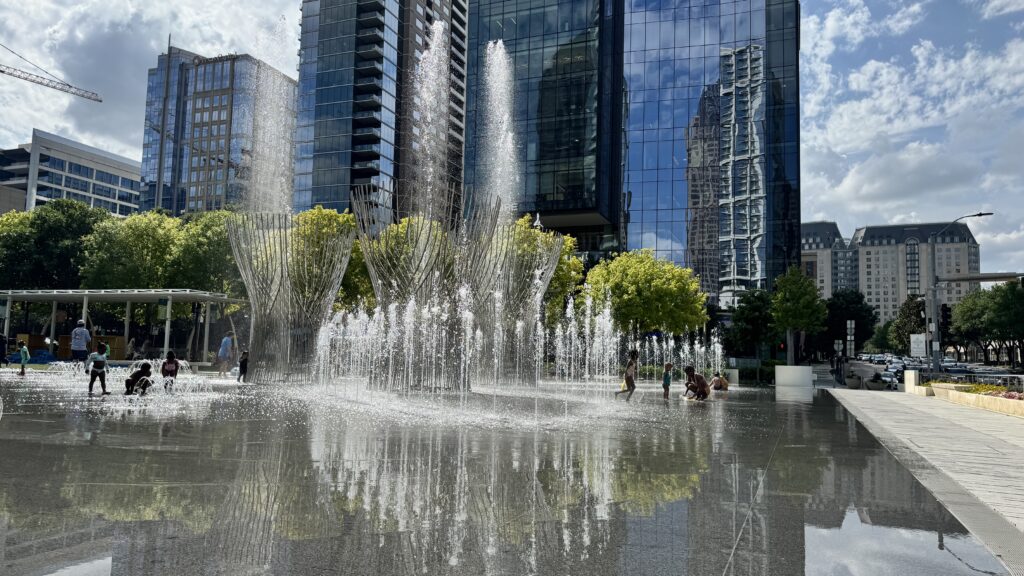
Green + Blue Spaces
Klyde Warren Park is an urban lawn with a kids’ zone, splash pads, pavilion, restaurant, food trucks, and outdoor game areas like ping pong or foam blocks. It has a list of coming attractions as it entices and drives visitor usage through targeted events bringing folks together. The Katy Trail is different. It is self-programmed. You are in control of your pace and how social you wish to be, meandering near the Turtle Creek but never actually interacting with it. Both well-known urban green spaces drive up real estate value and commercial development. A similar concept containing elements revolving around water and riparian areas is called a blue space. These too are said to positively affect how we think and how often we move our bodies, which directly support our mental health and overall well-being. Not only that, but they help remove air pollutants, extreme heat, and noise, and aid in reversing the heat island effect. A well-known local blue space is White Rock Lake. It has an 8-mile loop for exercise and multiple areas to get near the water’s edge. Though swimming is not celebrated there, it still does bring peace of mind and enjoyable summer breezes near the shore.
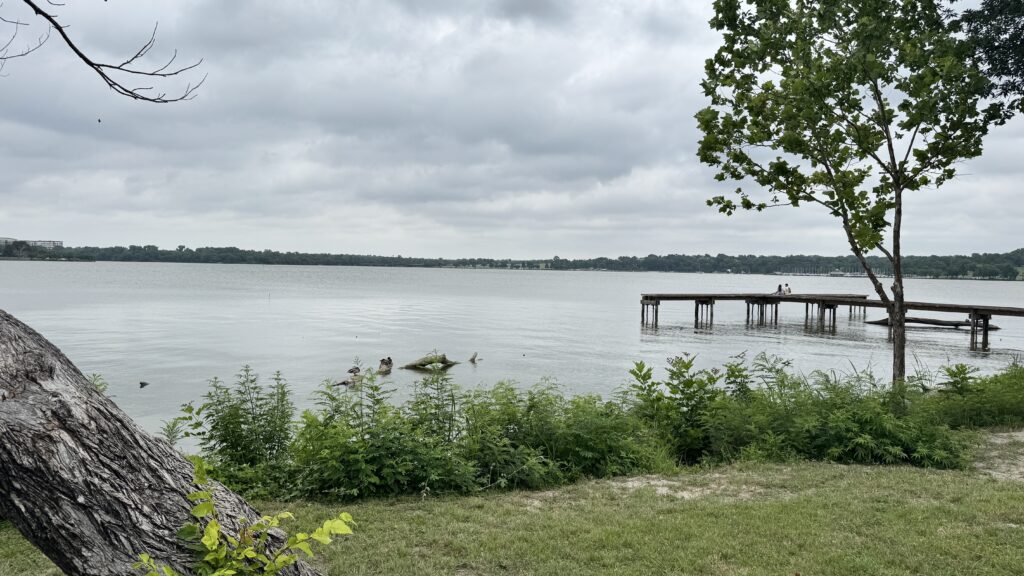
Mental clarity and regulation are becoming more celebrated. With 55% of the global population living in urban areas (and expected to rise), the congestion and density are overwhelming in dense urban centers. Imagine a day in the life of an office-working Dallasite, beginning in an air-conditioned dwelling, battling traffic in an air-conditioned vehicle, working in the air-conditioned office, back to the highway, and then ending on the couch with the same ol’ hum of A/C. Sure, we have some comfort in that routine, but in the long run, it’s questionable if we are supporting our community—or just living in one.
If it were available, we might take a walk around a lake or watch a family splashing in a public fountain. We could bump into a neighbor (or stranger) by chance and talk about “whatever” while being active and breathing fresh-er air. We could watch the birds and squirrels while our biological clock connects to the rising or setting sun. This moment of pause and reflection is critical to offset and reboot our “always on the go” predictable patterns. Let’s push this conversation forward to appropriate green and blue spaces for positive design impacts in the ever-expanding suburban network that is DFW. We owe it to ourselves and our fellow humans to bring the best to the table. Without each of us focusing on positive interactions and mindfulness while creating new habits and self-regulating the rising temperatures, the HEAT will surely scorch us.
